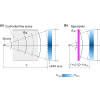用空间板缩小梯度指数透镜天线系统
IF 4.4
2区 物理与天体物理
Q2 PHYSICS, APPLIED
引用次数: 0
摘要
光学系统的微型化是整个电磁频谱领域一直面临的挑战。虽然超材料技术的发展可以减小光学元件本身的厚度,但占据大部分体积的却是这些元件之间的空隙--它们是光学系统的必要组成部分。最近,一种被称为 "空间板 "的新型光学元件被提出,这种光学元件用更薄的光学元件取代了自由空间区域,模拟了自由空间的光学响应功能,因此有可能大幅缩小光学系统的体积。虽然已经有一些空间板的原理验证演示,但它们尚未在实际光学系统中部署。在这项工作中,我们使用定制设计的空间板来缩短梯度指数(GRIN)透镜微波天线的长度。我们发现,传统天线和空间挤压天线的辐射模式非常相似,交叉极化非常低,引入空间板后侧叶水平仅略有增加。我们的工作是将空间板集成到在微波频谱区工作的实际光学系统中的一次演示,凸显了这一概念在缩小成像、光谱学、雷达和通信等应用系统的物理尺寸方面的潜力。本文章由计算机程序翻译,如有差异,请以英文原文为准。

Shrinking a gradient-index-lens antenna system with a spaceplate
The miniaturization of optical systems is an ongoing challenge across the electromagnetic spectrum. While the thickness of optical elements themselves can be reduced using advances in metamaterials, it is the voids between these elements—which are necessary parts of an optical system—that occupy most of the volume. Recently, a novel optical element coined a “spaceplate” has been proposed, which replaces a region of free space with a thinner optical element that emulates the free-space optical response function—thus having the potential to substantially shrink the volume of optical systems. While there have been a few proof-of-principle demonstrations of spaceplates, they have not yet been deployed in a real-world optical system. In this work, we use a bespoke-designed spaceplate to reduce the length of a gradient-index- (GRIN) lens microwave antenna. Our antenna is designed to operate at 23.5 GHz and the incorporation of a nonlocal metamaterial spaceplate enables the distance between the antenna feed and the GRIN lens to be reduced by almost a factor of 2. We find that the radiation patterns from a conventional and space-squeezed antenna are very similar, with a very low cross-polarization, and only a minor increase in the side-lobe levels when introducing the spaceplate. Our work represents a demonstration of a spaceplate integrated into a real-world optical system operating in microwave spectral region, highlighting the potential for this concept to reduce the physical size of systems in applications including imaging, spectroscopy, radar, and communications.
求助全文
通过发布文献求助,成功后即可免费获取论文全文。
去求助
来源期刊

Physical Review Applied
PHYSICS, APPLIED-
CiteScore
7.80
自引率
8.70%
发文量
760
审稿时长
2.5 months
期刊介绍:
Physical Review Applied (PRApplied) publishes high-quality papers that bridge the gap between engineering and physics, and between current and future technologies. PRApplied welcomes papers from both the engineering and physics communities, in academia and industry.
PRApplied focuses on topics including:
Biophysics, bioelectronics, and biomedical engineering,
Device physics,
Electronics,
Technology to harvest, store, and transmit energy, focusing on renewable energy technologies,
Geophysics and space science,
Industrial physics,
Magnetism and spintronics,
Metamaterials,
Microfluidics,
Nonlinear dynamics and pattern formation in natural or manufactured systems,
Nanoscience and nanotechnology,
Optics, optoelectronics, photonics, and photonic devices,
Quantum information processing, both algorithms and hardware,
Soft matter physics, including granular and complex fluids and active matter.
 求助内容:
求助内容: 应助结果提醒方式:
应助结果提醒方式:


